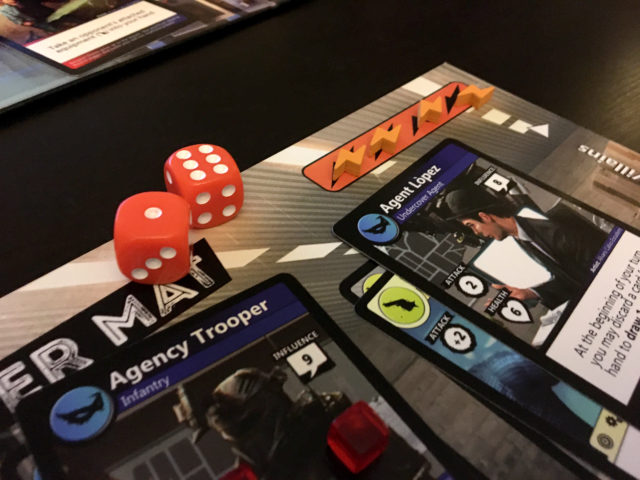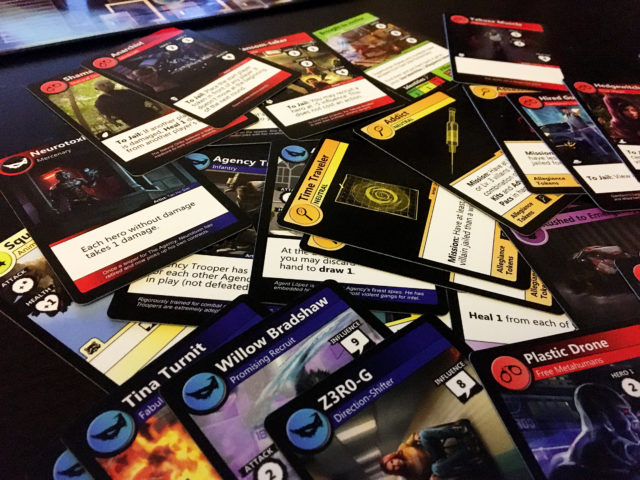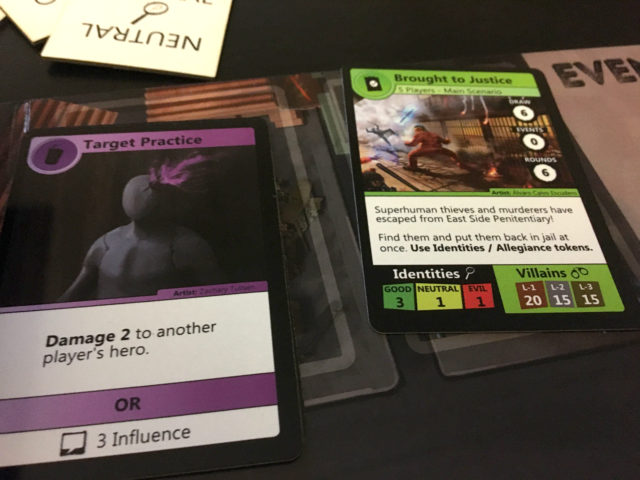If you’ve ever envisioned yourself as a leader of great heroes, like Dr. Xavier forming the X-Men, or Lex Luthor creating the Legion of Doom, if you are a bit more devious, than Vigilante might be the game you are looking for.
The elevator pitch for Vigilante is that it’s a cross of Sentinels of the Multiverse and Dead of Winter. There is much more going on in the social-deduction game, but that’s a good entry point into the ideas behind Vigilante designed by Reed Mascola.

In Vigilante each player (it plays between 3 and 6 players) has a team of superheroes (up to 4) that they can recruit and equip with weapons and vehicles. Depending on the scenario being played (there are 10 different ones in the game) players are given secret goals. Those goals also identify what team you are playing for: Good, Neutral and Evil. In most cases the Good team is trying to defeat villains. The goal of Evil players is, generically speaking, to stop the Good guys, while the Neutral players have goals that could help or hurt either side, or not affect them in any way. So you can throw in a little of Shadow Hunters into the elevator pitch while we are at it.
On your turn you have four actions, tracked with four cool wooden lightning bolts. The actions include drawing cards, trading cards to another player, recruiting heroes, attack a villain, heal your heroes and take equipment cards back into your hand. There are also some free actions such as playing a card.
The cards you draw will help you recruit heroes, by using their influence value, heal your heroes, boost your heroes attack and defence through equipment and look at other players allegiance tokens. How you use the cards in your hand is very important in Vigilante. Is it worth using two or three cards to recruit a new hero? Or is better to save the health kit to heal your hero later on or equipping them with a weapon?

The cards that let you find out someone’s allegiance tokens are very sought after, especially by the good players. Each person is given four allegiance tokens at the beginning of the game that say Good, Evil and Neutral. Each player will have a Good, Evil and Neutral token and your fourth token will be based on what team you are actually. If you are able to look at two different allegiance tokens of one player and they are both the same, you now know what side they are on. If you share that information with the other players, well that is for you to decide. To get those cards they are in the Agency deck, which is only available to draw from once you have killed three villains. Otherwise you will be drawing from the Main deck.
Speaking about killing villains one of the best aspects about Vigilante’s social-deduction aspect is that all players are encouraged to attack villains and hopefully jail them. The villain deck gets harder and harder as the game goes on so it’s in your best interest to attack early or you might be facing Level 2 or Level 3 villains. Evil team players are incentivized to defeat villains early because it will make it harder for the Good team to reach their goal by forcing them to take on tougher villains. This makes it easier to hide if you are on the Evil team. You can wait until later in the game to pounce and make your presence known.
There is an old saying which says, “Save the best for last,” which is why I have resisted bringing up the Events aspect of Vigilante until now. At the beginning of each round the first player draws two Event tokens and places one of them face up. Each token has a die number and an ability on them. Some of these abilities will help players by letting them draw cards or heal heroes. Most are not positive, forcing players to discard cards, damage a hero or uh…oh…free a villain. Evil players can draw negative Event tokens and claim, “Well the other one was worse.”

These tokens stay in the game forever. At the end of each round everyone rolls two dice behind a player screen and have to submit one of the dice. If any of the dice submitted matches any of the Event tokens, they are activated. For the first couple of round the odds of rolling number that might trigger negative Events but near the end of the game, through either bad luck or good play by the Evil player(s), there could be circumstances where Good players are submitting dice that free villains and cost them the victory. While some boardgamers might begrudge a mechanic that means a game comes down to a random die roll, it means the game really builds up to a climax, instead of petering out as many games to. Also there are plenty of ways to mitigate the bad die rolls throughout the game.
The components of Vigilante are high-quality and the game offers a fun, interesting gaming experience that is different than other games out there. Vigilante will bey available on Kickstarter in September.
Vigilante is a deck-building, social-deduction, semi-co-operative board game for 3-6 players that plays over 45 to 120 minutes. It is designed by Reed Mascola with art by Álvaro Calvo Escudero, Patrick Turner and Tan Ho Sim. It is published by Paranoia Rising Games Inc.
Comments
No comments yet! Be the first!